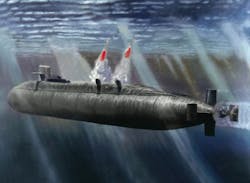Raytheon to devise ways of ballistic missile submarine protection using technologies like signature modeling
ARLINGTON, Va. – Underwater warfare experts at Raytheon Technologies Corp. will develop new ways of protecting the U.S. nuclear ballistic missile submarine that do not involve sound or sonar under terms of a $9.5 million contract announced last week.
Officials of the U.S. Office of Naval Research (ONR) in Arlington, Va., are asking the Raytheon Missiles & Defense segment in Portsmouth, R.I., to pursue the Science and Technology Research for the SSBN Security Technology Program (SSTP) program, also referred to as Oban 3.
Raytheon researchers will investigate physics-based non-acoustic phenomenologies of nuclear ballistic missile submarine security, and develop new products in signature modeling and validation, clutter modeling and validation, signal processing algorithms, and countermeasure concepts.
The goal is to improve the survivability of U.S. ballistic missile submarines -- particularly before they have time to fire their weapons, by gaining knowledge of threats to submarines that involve underwater detection, tracking, and engagement.
Related: EO/IR sensors boost situational awareness
Non-acoustic submarine protection involves submarine-induced hydro-dynamic signature generation, propagation, and decay models of submarine hydrodynamic wakes, and detecting submarine masts and periscopes with radar.
Other non-acoustic submarine-protection approaches can involve AC and DC electromagnetic signature measurements on submerged submarines; detecting submarine wake signatures on the ocean's surface with infrared sensors and optics; detecting bioluminescence patterns; and detecting submarine hulls with airborne laser radar (ladar).
New approaches are possible that involve understanding the physical phenomenology of submarine detection and tracking; characterizing the natural ocean environment; and anti-submarine warfare (ASW) tactical decision aids.
On this contract Raytheon will do the work in Portsmouth, R.I., and should be finished by August 2024. For more information contact Raytheon Missiles & Defense online at www.raytheonmissilesanddefense.com.
